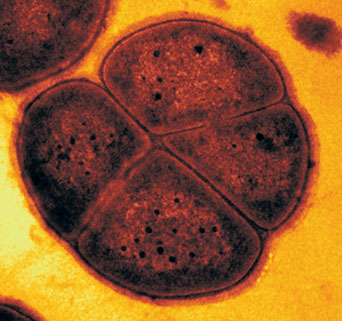Deinococcus radiodurans – the future of printing?
A thought about Christian Bök’s epic act of minimalism taken to its logical conclusion, Xenotext, has been haunting me since the Bury Text Festival. As I understand Xenotext, it’s an attempt to imprint a short lyric poem into the DNA of a particular single-celled bacterium in such a way that will cause the bacterium to create a benign protein that, when “read” in the same “language” as it was written, would generate a second short poem, the words, order, lines & line breaks of which Bök also already knows. Because the bacterium he has selected for this act of signage is Deinococcus radiodurans, an extremophile, a bacterium that lives at – indeed is happiest in, to the degree that one might assign bacteria emotions – exceptionally hot & caustic environments¹, it is one that could conceivably survive at least up to an explosion of the sun terminated life as we know it. It is in this sense an attempt to create an immortal poem, one that could easily outlast not only the English language & humanity itself, but even sentient life on the planet on which it was originally inscribed. In Bury, Bök characterized Xenotext as the first such attempt at literary immortality.
So here’s what haunts me: How do we know?
If, for example, one Canadian might conceive of such a project, how do we know that elsewhere in the universe other species have not likewise thought to imprint their deepest thoughts onto compliant organisms? Further, as we are now starting to discover archeological evidence of molecular life on various modes of stellar debris, why might some civilization not have thought even to create some sort of symbol akin to the NASA “hey there” message shipped off out into the universe awhile back. Maybe one of those fossilized bacteria in the asteroid belt is its own message from some Christian Bök type figure on an inner planet of some other star? (I refuse to imagine Jar Jar Binks in a purple shirt & tie.)
At one level, Bök’s project is audacious, a Faustian reach if ever there was one. At another, it’s pretty straight-forward and simple: implant the gene, see if the protein forms. Although it has taken years, and the assistance of a fair number of “real” scientists to aid this “plumber’s son” (as Bök likes to call himself) in bringing this project to fruition, Deinococcus radiodurans has cooperated & accepted the implantation of the engineered gene. Now we’ll see if it proceeds to go further and generate the corresponding protein.
It’s a fascinating idea, worthy of the author of Eunoia, a tour de force that would make Georges Perec feel envious. Yet the very god-like scale that Bök proposes in the project seems to me to invoke the likelihood that this has, seriously, been done before elsewhere. We just don’t what planet, what star system, maybe even which universe. And why stop with the explosion of the sun? As rocketry becomes more ordinary, enough so that Virgin can advertise space flight for $200K just down the road a bit, the day is coming when a poet might indeed send some extremophiles out there well beyond our solar system, ready to venture in search of readers anywhere in this particular universe.
So is what Bök doing writing? If anything, the technological processes being invoked on poor helpless Deinococcus radiodurans strike me as much closer to printing than authorship. Not unlike Tony Lopez’ signage at the Text Festival in Bury, which approximated a railway destination sign by producing the text first in Flash and then creating a videotape from that which was stored on a DVD to play on the wall of the Bury Arts Museum, what you see isn’t random or in the slightest bit arbitrary. Just as if he’d been laying cold type for an old Chandler letter press, Bök tells the little bugger what to say and what to do. Deinococcus radiodurans has no input of its own. It can’t change the text except by the rules always already set out for it. If it doesn’t produce the protein, then by Bök’s standards, the process will have failed (albeit this may well be the most heroic of failures). Further, without Bök’s own translation key, the resulting text would be unreadable, whether or not the experiment worked or you knew to look into the genetic make-up of our little friend.
Am I sure that this is what Goethe, Milton, Dante had in mind? On one plane, I think the answer is yes, resoundingly so, but on another, it feels more like the movie Black Swan where CGI and body doubles create an impression of dance. Christian Bök gives great simulacra.
¹ Picking an extremophile pretty much ensures that Bök’s poem won’t get into your cornflakes any time soon, but there is a subtext here, making genetically engineered poetry as a means of rendering genetic engineering “avant-garde” or “cute” even, that will no doubt bother some readers.






